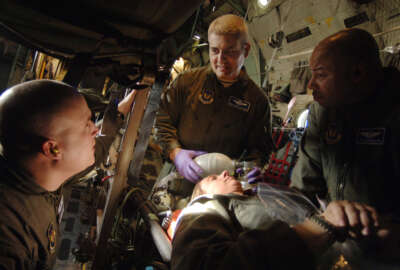
COVID-19 throwing a wrench in DHA transition plans
Three big reforms in military health are being reconsidered due to the pandemic.
COVID-19 has the Defense Health Agency checking its math on some of the biggest reforms it’s conducting within the Military Health System, and may derail some of those efforts.
DHA was planning on offloading about 200,000 TRICARE beneficiaries from treatment at military clinics, and sending them to private practitioners in the local community. However, DHA Director Lt. Gen. Ronald Place said Thursday that the Defense Department isn’t sure certain localities will be able to handle the influx of patients anymore.
“Some outpatient physicians’ offices have either downsized or closed themselves,” Place said during a Defense Writers Group event. “Some hospitals across America have either downsized or closed. So some of the information that we were relying on to make recommendations to the department about where the capability may exist in the civilian community to effectively provide access to safe, high quality care for some of these beneficiaries, that information may no longer be true.”
Place said DoD now needs to go out and reassess the medical markets because the data is outdated. He doesn’t expect a decision to be made until early 2021.
That’s not the only reform that COVID is throwing out of whack, though. DoD was planning on cutting as many as 18,000 medical billets and filling them with combat forces to make the military more lethal.
Place said that decision is on hold, as DoD reassesses it as well.
A final reform is being reconsidered in part due to COVID and also because of concerns from the military services.
All of the services were supposed to transition their military treatment facilities to DHA’s control by 2022.
However, in August the leaders of each military service wrote a letter asking DoD to rethink the move.
“The DHA end-state, as designed, introduces barriers, creates unnecessary complexity and increases inefficiencies and cost,” the military officials wrote. “Service command and control of the MTFs as military units, through our direct support, was critical to commanders’ operational response [to coronavirus] and swiftly adjusting resources across the enterprise.”
DoD and Congress both said they will move ahead.
“The department is continuing to implement the direction as legislated by Congress and signed into law by the president,” Pentagon spokeswoman Lisa Lawrence told Federal News Network in August. “The department remains focused on ensuring the services maintain a medically ready force and a ready medical force, as well as ensure all eligible beneficiaries have continued access to quality healthcare.”
Place was more diplomatic and said DHA and DoD are working together to find common ground with the services.
“There was a requirement for my organization to come back with recommendations on what things should be considered to start the transition process again,” Place said. “We’ve done that. At the same time, leaders within the military departments have brought forward some additional concerns that they believe the leaders of the Department of Defense should take into consideration, and should inform what a future state should look like.”
That included taking COVID into account, the effect of moving research and development to DHA and the effect on each military installation.
Some of the recommendations DHA put forward included figuring out where decisions were made.
“Where’s it appropriate for decision making to be made centrally for an enterprise decision and where is it appropriate for decisions to be made at an installation level?” Place said. “For example, an infectious disease is a particular case and casualties may be a different case. They affect individual installations differently. How much authority left and right of that normal standardization should an installation leader have? Those are the things that we’re trying to work through. Those are the factors that have come up within COVID-19 that the department didn’t have a complete plan rolled out on.”
Place said a decision on that could be made within a month.
Currently all the reforms are on hold and have been on hold since the start of the COVID-19 pandemic.
Copyright © 2025 Federal News Network. All rights reserved. This website is not intended for users located within the European Economic Area.
Scott Maucione is a defense reporter for Federal News Network and reports on human capital, workforce and the Defense Department at-large.
Follow @smaucioneWFED






